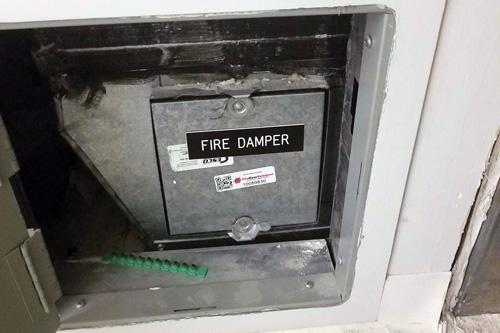Damper rules for wall openings, penetrations

3 years ago
Note: This is Part 3 in a series:
By Ellen McCulley
Licensed Architect, Nelson Design, Inc.
Q: What are the requirements for fire smoke walls? (Continued)
A: In Part 1 of this series, I discussed the building codes that are typically applicable for healthcare facilities. I also went into detail on the various types of fire-rated construction and their respective uses in both the International Building Code (IBC) and NFPA 101 Life Safety Code. In Part 2, I covered the requirements for window and door openings in fire-rated construction. Part 3 will cover duct openings in fire resistance-rated assemblies.
The building code requirements for penetrations and duct openings take time to properly assess, as there are several exceptions in the code. In fact, our office created a three-page flow chart that assists us in evaluating and providing the code-required installation for our clients. We would be pleased to assist you in determining the penetration and opening requirements for your building.
Dampers may be required to protect duct openings where ducts pass through or terminate at fire-rated assemblies. This helps to prevent fire and smoke from spreading to other parts of the building. Dampers are important in protecting both the building and the life safety of the occupants.
The NFPA 101 references NFPA 90A, Installation of Air Conditioning and Ventilating Systems, for requirements pertaining to openings in fire barriers for air-handling ductwork or air movement. Fire dampers are generally required in ducts that penetrate walls that are rated for two hours or more, and at air-transfer openings in rated walls. Fire dampers are sometimes required at rated floor assemblies and vertical shaft enclosures as well.
Smoke dampers are typically required at each point a duct or air transfer opening penetrates a smoke barrier. One main exception to the aforementioned rule is smoke dampers are not required in smoke barrier walls used to separate smoke compartments where the building is sprinklered throughout and equipped with quick-response sprinklers and the HVAC system is fully ducted. This exception applies to I-2, Condition 2 occupancies, such as hospitals. It does not apply to I-2, Condition 1, such as nursing homes. Smoke dampers are also required at air transfer openings in smoke partitions.
If you have any questions on this article or have other code related questions, please contact me.

About the Author
Ellen McCulley graduated magna cum laude with a Bachelor of Architecture degree from Iowa State University, where she received the Pella Architectural Award from the Department of Architecture in the College of Design. She is a registered architect in Iowa, Illinois, Nebraska and Missouri, and joined Nelson Design, Inc., a wholly owned subsidiary of Carl A. Nelson & Company, in 2012.
How to obtain code review for your project or facility
Carl A. Nelson & Company is available to help clients address code-related issues in their facilities. Call (319) 754-8415 and ask for Ellen McCulley. Review past installments of Decoding the Code at www.carlanelsoncoconstruction.com/decoding-the-code/